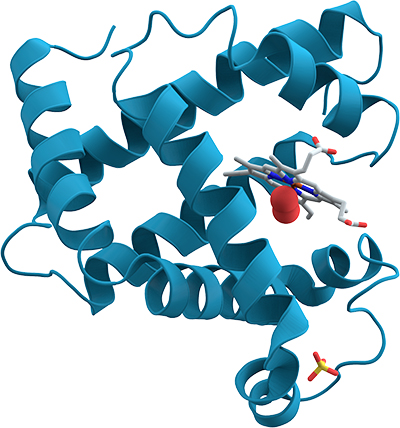MCP: Study shows long-term effects of weight loss on the proteome
As hard as weight loss is, long-term maintenance can be even more of a challenge. But research published in the journal Molecular & Cellular Proteomics indicates that the hard work of maintaining weight loss can pay previously unknown health dividends.
 Proteomics researchers found that many plasma proteins, such as myoglobin, shown at left, increase in nonenzymatic glycation after patients lose weight. It takes six months to a year of sustained weight loss for glycation to drop below baseline levels. PDB / S.E. Phillips
Proteomics researchers found that many plasma proteins, such as myoglobin, shown at left, increase in nonenzymatic glycation after patients lose weight. It takes six months to a year of sustained weight loss for glycation to drop below baseline levels. PDB / S.E. Phillips
Using plasma samples from a study that followed people as they lost weight and worked to keep it off, researchers at a Swiss proteomics company called Biognosys, in collaboration with a team at Nestlé, studied how weight loss affected participants’ blood proteome. They observed that while chronic inflammation subsides immediately after weight loss, it takes some time for added beneficial effects to kick in.
The diet, obesity and genetics study, or DiOGenes for short, was designed to test the benefit of various diets in maintaining weight loss. Among the 550 participants who lost 8 percent or more of their starting weight and stayed in the study for another six months, researchers reported in 2010, those who followed a high-protein, low-glycemic-index diet were most successful at keeping it off.
More recently, researchers at Biognosys led by Lukas Reiter used a streamlined proteomics approach to analyze patient plasma samples from the start of the study, the end of its eight-week weight-loss phase, and six and 12 months into the maintenance phase. Consistent with other weight-loss studies, the team saw a dramatic, lasting drop in inflammatory signaling linked to atherosclerosis and an increase in lipid metabolism soon after weight loss.
Because of the depth of their proteome coverage, the Biognosys researchers could add a look at protein glycation. Nonenzymatic glycation occurs when high concentrations of sugar react with proteins in the plasma. Many of the glycated proteins that changed significantly during weight loss, including albumin, myoglobin and some apolipoproteins, were unexpectedly more abundant after the study’s initial weight-loss phase. It took more than six months on the weight-maintenance diet for those glycated proteins to drop back below their baseline levels. Because glycated proteins can activate the immune system, the researchers wrote, the effect of longer-term weight loss is positive.
In future studies, the researchers who own the data hope to move from looking at the whole cohort’s proteome to correlating each study participant’s outcomes with the composition of that individual’s proteome at baseline in search of biomarkers that could help predict how future dieters will fare. Meanwhile, the Biognosys team wants to use its analytic abilities to power high-throughput proteomics for clinical trials.
Enjoy reading ASBMB Today?
Become a member to receive the print edition four times a year and the digital edition monthly.
Learn moreGet the latest from ASBMB Today
Enter your email address, and we’ll send you a weekly email with recent articles, interviews and more.
Latest in Science
Science highlights or most popular articles

Fueling healthier aging, connecting metabolism stress and time
Biochemist Melanie McReynolds investigates how metabolism and stress shape the aging process. Her research on NAD+, a molecule central to cellular energy, reveals how maintaining its balance could promote healthier, longer lives.

Mapping proteins, one side chain at a time
Roland Dunbrack Jr. will receive the ASBMB DeLano Award for Computational Biosciences at the ASBMB Annual Meeting, March 7–10, just outside of Washington, D.C.

Exploring the link between lipids and longevity
Meng Wang will present her work on metabolism and aging at the ASBMB Annual Meeting, March 7-10, just outside of Washington, D.C.

Defining a ‘crucial gatekeeper’ of lipid metabolism
George Carman receives the Herbert Tabor Research Award at the ASBMB Annual Meeting, March 7–10, just outside of Washington, D.C.

The science of staying strong
Muscles power every movement, but they also tell the story of aging itself. Scientists are uncovering how strength fades, why some species resist it and what lifestyle and molecular clues could help preserve muscle health for life.

Bacteriophage protein could make queso fresco safer
Researchers characterized the structure and function of PlyP100, a bacteriophage protein that shows promise as a food-safe antimicrobial for preventing Listeria monocytogenes growth in fresh cheeses.

